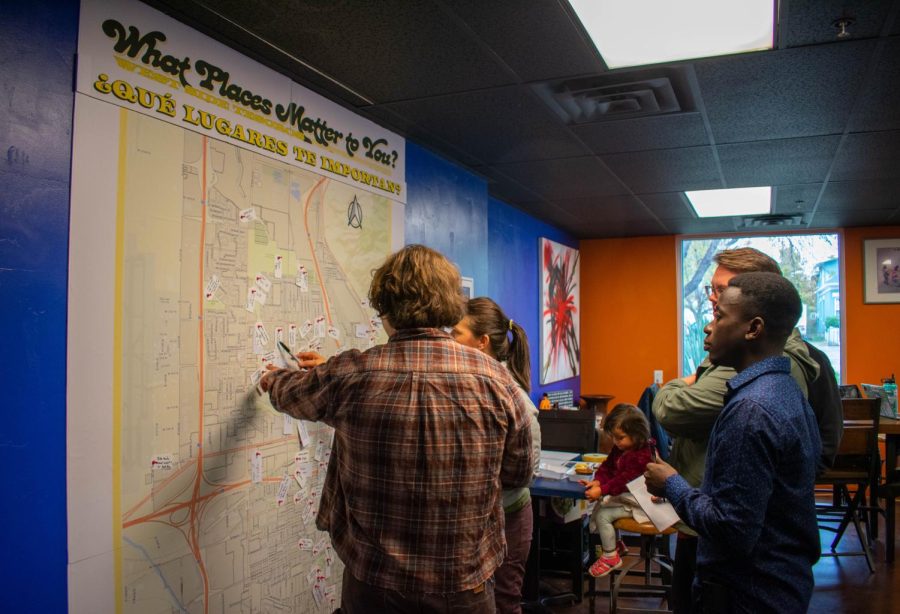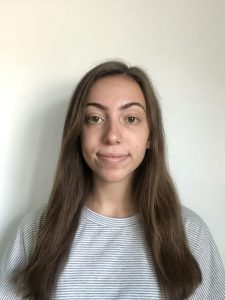West Side Community Placekeeping Project Preserves Memories Amid Cultural Displacement
Salt Lake City locals add places that matter to them on a map of the West Side of Salt Lake City at Mestizo Coffeehouse in Salt Lake City on Saturday, Nov. 5, 2022. (Photo by Andrea Oltra | The Daily Utah Chronicle)
November 10, 2022
In the wake of mass cultural displacement in Salt Lake’s West Side, residents gathered in Mestizo Coffeehouse to remember places that feel like home. They drank coffee and shared stories of their memories of meaningful places on the West Side, as part of a new community placekeeping project called West Side Tesoros.
Created by Maria Garciaz, the CEO of NeighborWorks Salt Lake, Jasmine Walton, the director of community initiatives and marketing at NeighborWorks and Caitlin Cahill, an adjunct associate professor in the University of Utah’s Department of City and Metropolitan Planning, the project aimed to hear directly from West Side residents about the places they know and love.
They partnered with Housing SLC, the city’s five-year housing plan, and were informed by Thriving in Place, a community-driven, anti-displacement project.
Gathered around the shop’s wooden tables, U students interviewed West Side residents about places reflective of belonging, culture, time and values. Residents could also submit their “tesoro,” Spanish for treasure, online. The group hopes to collect 50-80 tesoros before the map is digitally archived.
On the opposite wall hung a map of the West Side which read “What places matter to you?” and in Spanish, “¿Qué lugares te importan?” From Rose Park, to the Utah State Fairgrounds, red pushpins commemorated the places residents identified as meaningful.
Cahill said when talking about community development, those in metropolitan planning frequently discuss asset mapping, a process where positive resources within a community are identified. When thinking about the West Side, Garciaz thought the idea of treasure mapping would resonate more with the community — so, they went with “tesoros.”
Salt Lake City is currently in a housing crisis — rent is increasing, and tenants have limited rights, Cahill explained. In addition, residents are becoming alienated and physically forced out of their homes, with nowhere to go.
Cahill said this project is important to raise consciousness, especially for younger people, to understand the history of the places they frequently interact with, before the memories are erased with the buildings.
“They see this every day and this is part of their everyday lives,” she said. “And it’s a sense of cultural identity, but what happens when we lose those places?”
A Pin on the Map
One tesoro identified by multiple residents is Mestizo Coffeehouse.
David Galvan, its co-owner, said his coffee shop is “created by community, for community.”
The vision for the shop was to combine art, culture and coffee in one place. When it was founded in 2008, it was the only coffee shop on the West Side.
“We’ve had exhibits that deal with immigration, obviously over the years prior to it becoming a hot topic,” Galvan said. “And I’d walk in and see new arrivals that are here, immigrants that are here, and they’ve never seen themselves [as] part of the exhibit.”
Galvan said their customers are very diverse, with many viewing the shop as a “safe house.”
“We’re welcoming,” Galvan said. “We like it if you like coffee.”
Mestizo Coffeehouse was chosen as the location to house the placekeeping project because of the shop’s history of community engagement, and its significance to the West Side community.

Beyond Housing
Two students conducting interviews, Justice Tuffour and Parviz Faiz, said the West Side is defined differently by different people.
“I-15 is kind of the standard boundary line that people have put in a modern world, but these neighborhoods existed before I-15 was in place … it was chosen — the place of I-15 — to separate disenfranchised neighborhoods,” Faiz, who uses he and they pronouns, said.
With gentrification, physical and cultural displacement rising on the West Side, Faiz said it is important to speak with residents to understand how the West Side’s cultural identity is created.
“It’s not only those physical locations but the fact that like, people are overlapping in those and talking to each other and creating that neighborhood identity through a subliminal force,” Faiz said.
Tuffour said displacement and gentrification are not simply about housing.
“You know, there are places that hold meaning or significance to people that’s not just housing,” he said.
According to Tuffour, there was a lot of engagement with the project — from residents sharing stories from the 70s to places they would visit with their dad, there was a sense of community developed through putting a red pin in that map.
The changing landscape of the West Side was made apparent through stories that spanned periods of time, Faiz explained — what once was a band’s practice base and friend’s childhood home, is now a parking lot.
In the city and metropolitan planning program, Faiz said they often focus on the technical aspects of urban planning, such as financing a home. But this project socialized the issue, they explained.
“What are people feeling when they’re being displaced?” he said. “Like how are people feeling that their neighborhood is changing? All these aspects that are in a big conversation between people I know and communities but not necessarily on a legislative level … it’s another piece of the puzzle that is often looked past.”
If Pushpins Could Speak
As residents of the West Side, Leticia Alvarez Gutiérrez, an associate professor of education, culture and society at the U, and Jonathon Marshall, felt it was important to share meaningful landmarks through this project.
Gutiérrez, who uses ella and she pronouns, moved to the West Side in 2007 because it felt “like home.”
“The neighborhood is changing quite a bit right now, with gentrification, so it has its really negative impacts,” ella said. “But it also has so much to contribute to our community and it’s oftentimes not as valued as other parts of the city.”
Marshall and Gutiérrez both said they have a beautiful place to live, but it needs more resources and support to get back to what it once was.
“So it’s becoming very unaffordable for working-class families who have been here for many years,” Gutiérrez said. “And so I think it’s important that the city start really paying a little more close attention to our neighborhoods over here on the West Side, for sure.”
According to Marshall, one tesoro that was almost taken away in March 2021 was a historic LDS meeting house intended to be razed.
“Through the community council, we helped sort of save that and now they’ve restored it,” Marshall said. “It’s going to be an event kind of place.”
Their other tesoros included El Jaripeo Taco Truck, All Chay restaurant, Panaderia Flores and Golden Pearl restaurant.
Tuffour said this project is not just about the pins on the map, but also the “stories behind them.”
The floor-to-ceiling map currently located in Mestizo Coffeehouse will be digitally archived, with a collection of the media gathered throughout the project. It will remain in the shop for residents to contribute to, with plans for the physical map to be relocated to the Glendale-Mountain View Community Learning Center. According to Cahill, the map “has to be owned by the community.”
“It’s voice memos, it’s photos, it’s handwritten stories, it’s drawings and quotes from our online survey that is all going to be compiled into this digital map,” Faiz said. “To bring more than just a pin in a map, it’s a voice of who is putting the pin there.”









